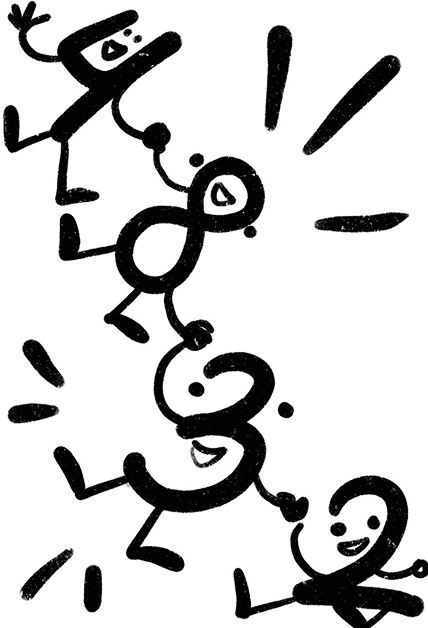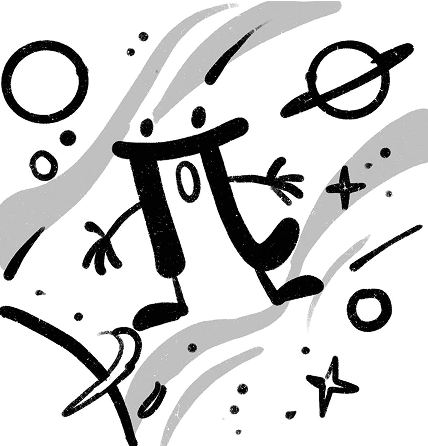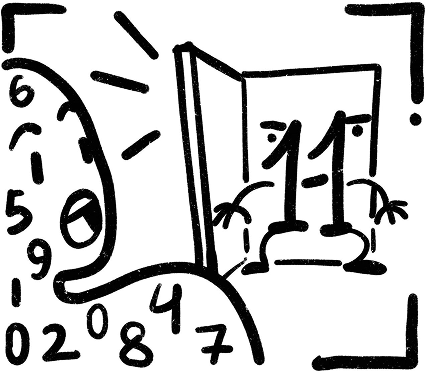Category: Cognitive technologies
Higher mathematics of the future: numbers of a new era
“We no longer calculate the world—we negotiate with it.
And it seems, at last, it’s ready for dialogue”
Doctor of Physico-Mathematical Sciences Gerda Ponzel
Companion Number: the Counting Parasite
— Could you show me once again where exactly I need to tap so something appears right here?
— To change the balance of your payment method, you need to spend more funds. The functionality of your new card is based on the companion number—a quantity that is a non-constant constant.
We’ve really come to this. It used to be that you had to hold numbers close, protect them like little children, nurture them, and give them away reluctantly. Now, some unknown surrogate from the OpenAI family calmly informs me in a perfectly measured voice that new numbers have appeared—numbers you have to spit out into the void immediately after interacting with them. Moreover, the more often you release these numbers, the stronger they multiply.
And how exactly is one supposed to wrap their head around that?
So, all day long, with all the refined serenity of an intellectual, you have to slave away under fluorescent lights (by the way, despite all the neural network intimidations, work itself hasn’t been canceled), and the moment you hear that cherished “clang” (that’s the sound your money drops onto the card), you must immediately spend every last cent. Whoever does it faster fattens their companion number right away. And so it goes every time: to save, you must spend.
Michael had a funny case recently. Money arrived at exactly the wrong moment—while he was in the restroom. Out of inexperience, he forgot to charge the embedded microchip in his eye that controls his entire existence. He missed the moment. A few seconds later, the money was gone—vanished, just like your desire to return to a stable past. That’s it, folks. From now on, we live only in the present.

Where did the idea to invent companion numbers come from? You should ask your own generation. Now, you will, of course, start confessing like nightingales about cashback, mining, and all sorts of taps, but this number wasn’t invented for those reasons.
Scientists studied evolution for many years and concluded that it’s easier to endure a minus than to wait for a plus. People became brazen with resources, hoarding them or even pretending to be poor to increase the flow of allocations. Algorithms based on comments got cocky too: negative commentary gave super positive reach almost instantly. Numbers started wandering uncontrollably on their own, accumulating where they absolutely shouldn’t be.
Suddenly, clever marketers stepped in, launching powerful campaigns with populist slogans: “Spending isn’t shameful. Spending more = Living longer,” “What’s yours isn’t yours, give it away to grow.” Sound familiar?
You got carried away with these games, placing positive numbers above all else, while the actual resource depreciated, and now we have to get used to interacting with sadistic numbers and a new reality: want to change a number? Make it negative.
The companion number 𝒦∿ reflects the entirety of human greed. Calculating the companion number is simple:
𝒦∿ = ((Δ × V) / S) + R
Where:
Δ — income (profit),
V — eagerness (variatio),
S — conscience,
R — a reserve, an empty bonus that is always added, like fat.

Conscience is the most painful element in this formula, because all the hoopla happening inside the parentheses (Δ × V) must mercilessly be divided by the sum of moral principles.
We wanted so badly to make numbers smart that we endowed them with a soul. Now they behave like capricious deities: demanding sacrifices, leaving if you desire them too much, and returning only when you forget about them.
This is the new magic—not found in candles or spells, but in a quiet pact with the system we all now live in: in the pause between inhalation and exhalation, between a payment and its confirmation. We fall asleep to the monotonous hum of servers softly singing in our ear: “Your emptiness is my fullness. Your minus is my plus. Your trust is my currency.”
They say if you stare long enough at the calculations of the number 𝒦∿, somewhere in the back of your mind an age-old formula emerges:
“To have nothing—in order to gain everything.” The key is not to pay attention to the denominator.
Zero without a zero: the math of uncertainty
How about this message from the future? I’ve got Ø on my card again!
And the number Ø isn’t an error—it’s a new option called “Financial Uncertainty Premium,” promising less stress about your balance.
The number Ø belongs to the set of implicit numbers because it means zero and not zero at the same time. Sounds strange? That’s just for now—in the future all humanity will reach a systematic understanding and will marvel at everything implicit, even numbers.
It’s hard to remember who first came up with using this number. In alternative education systems, there are fragmentary mentions of how 21st-century people invented new ways to express uncertainty: “I’m neither online nor offline, I’m in a soulful search,” “we’re in over-friendship and under-relationship.” That’s when scientists found a solution: to create a number that reflects the very essence of the era—stubborn denial of the obvious.
This number is perfect for corporations: you can state that profit = Ø, and no one can prove it’s false. Ø is ideal for commitment-phobes, fans of ambiguous answers that humanity finally recognized as less toxic, for ironclad excuses, for self-deception, and even for a new encryption system (try to figure out what “ØØØØ” means).
At some point, people got tired of certainty—after all, it’s much cozier to live in a world where feelings can be measured as Ø (they may or may not exist), age can also equal Ø (25 by passport, 300 by feeling), and goals can be Ø—when you are sure of your uncertainty.

The number Ø is calculated by a simple formula:
Ø = ( (0.5 × ∞) / 0 ) × 1 + 1 = Ideal balance
Where:
0.5 × ∞ — “half-infinity”—a state when you feel kind of good, but not completely
Division by 0 is a forbidden move in classical mathematics, but a necessary condition to get the number Ø (otherwise, you get something definite)
×1 — the multiplier of philosophical calm
+1 — the minimal unit of happiness measurement
Perhaps it goes without saying why, why in the future, true adherents of classical mathematics will become fewer?
In a world where artificial intelligence gives half-truth answers, where the words “no” and “yes” mean “maybe,” where the weather forecast is almost never accurate, the anti-number Ø turned out to be the most honest mathematical object of all. The number Ø is not the absence of an answer (after all, it’s never equal to absolute zero); it is the highest form of freedom from the need to respond. Maybe that’s what mathematics should look like, so that people and numbers can better understand each other.
Bio-number: mathematics that thinks along with you
Remember how, before going to the store, you made a shopping list, avoided suspiciously processed meat, monitored discounts, and eagerly ate everything labeled “bio”? Still do that? Kudos! Now we have numbers with the “bio” prefix. You can’t eat them, of course, but thanks to them even recipes have become much more precise.
It all began when scientists slowly and not very accurately approached the secret of the number π. It kept accumulating new values, and physicists still weren’t being listened to. What’s more, this sacred number started changing its own established values: at first, slowly—once a year, then several times per second. You get what started, right? Engineers grabbed their heads and started inventing new formulas for calculations; mathematicians rushed to find loopholes in the exact sciences; cybernetics researchers tried to negotiate with π; and physicists quietly chewed seeds, observing all from the sidelines. The world convened a council and declared: “The number π communicates with gravitational waves. After the latest solar flare, it has ‘relaxed’ a bit.” (Here would be a good place for a native integration, like: “Even the number π relaxes—why don’t you? Choose the globe-trotting resorts of the Ermine company.”)
Thus humanity encountered the first bio-number—a number that behaves like a living being. And off it went…
In 2024, NASA scientists discovered that the number π behaves differently in space than on Earth. By 2047, quantum computers calculated that π changes when passing through black holes, and increases by 0.001% near neutron stars. Furthermore, String Theory allows constants to vary in other universes, and numerous experiments showed that in superconductors π decreases by 0.0001%.
In 2081, mathematicians officially renamed π to π̂, added a “hat” of variability, and formulated a new law:
The More Important the Constant—the More It Throws a Tantrum

But that’s not all! Poets of the new era began writing verses where the rhyme depended on the current value of the number π̂:
“The love code won’t converge–
Again 3.14.
The lunar cycle flared up,
Or are you just persistent?”
“Life is 3.1415 roads,
And 3.1416 worries.”
Think that’s the end? Far from it! Recently, I was invited to an artistic whistling class to imitate an infinite spiral, where we had to whistle fractal curls repeating the first 1000 digits of the number π̂. I managed to whistle only 999 digits, and only because I took yodeling lessons as a child.
After observing such strange behavior of π, scientists started paying closer attention to other numbers and discovered that they too began oscillating under external influences, changing their values like a teenager adjusting opinions depending on company. Numbers started exchanging properties: natural numbers, having spent time near the exponent, learned to grow sharply; and after befriending the imaginary one, began to take on any values. And you know what? Bio-numbers became much more accurate than ordinary ones. Such is the paradox of mathematics.
Bio-numbers take context into account and adapt to all necessary parameters. For example, calculating a drug dose became much simpler because 2.5̂ mg can factor in weight, need, allergy risk, and fitness tracker data.
Bio-numbers are multidimensional: they change their values depending on space curvature, which is why they are now widely used in navigation.
Bio-numbers correct human illusions. 1 + 1 = 2, but bio-mathematics knows that 1̂ apple + 1̂ orange equals a fruit salad, and if you add 1̂ truth and 1̂ lie, you get 1̂.5 of half-truth.
When physicists in the famous 2097 experiment replaced all the numbers in particle accelerator calculations with bio-digits, computational accuracy rose by 40%, because 0̂ in the equations automatically took quantum fluctuations into account.
Finally, bio-numbers are more honest. A static number 5 lies when it claims to be unchanging. But bio-number 5̂ openly states that today it lies somewhere between 4.8 and 5.2.
Bio-numbers are less precise at a given moment but more precise in the long term, because they rely on uncertainty.
It turns out we have always dreamed that the world would obey rigid formulas, that 2 + 2 would always equal 4 under any circumstances. We seek precision although we think approximately; we seek order yet continue to live in chaos; we crave constancy, yet ourselves change every second. By discovering bio-numbers, we have finally acknowledged that error is not the enemy of precision but its necessary part, and mathematics can be precise. And most importantly—honest.
A number that comes alive in the collective faith
And then, to this honest company of newborn numbers, another one was added—the legendary number, the mytho-digit 𝓜₇. I know, we initially resisted the influx of new quantities too, even went so far as to arm ourselves with picks and pitchforks, and, proud and red as lobsters, marched to the barricades. But then somehow we let it go and even came to accept it.
The mytho-digit 𝓜₇ didn’t arise out of nowhere. Its charm lies in the fact that it becomes true only when seen by 10 million people.
Advertisers of your time were the first to take notice: they discovered that sales multiply after the phrase “only 7 days of promotion.” Then historians began to spread the phenomenon further, recalling the 7 days of Creation in the Bible and the 7 deadly sins. Musicians joined in, citing the 7 notes. Casino dealers happily embraced the “777” jackpot, and then experimenters came with Miller’s Law—7±2. All these friends concluded that the part of the mytho-digit 7 works precisely because humanity has been programmed for 5,000 years to see magic in it.
True mytho-digits are not made, they are born from culture, a crisis of trust in data, an addictive economy, and neurobiology. Don’t believe me? Try making the number 46 a cult and you’ll see that it takes centuries of propaganda—just like the number 23 among conspiracy theorists.
After all the fuss around the ordinary number 7, neural networks calculated the formula of the mytho-digit, proving its direct link with neuromarketing:
Power = (Belief × Number of repetitions)/Skepticism
And thus began a new era of mass hypnosis through mytho-digits.
Corporations started using 𝓜₇ seven times more often than other numbers (according to Google Trends analytics of 2083). Social networks automatically began attaching 𝓜₇ to viral numbers. After 7 million repetitions, the number starts to influence behavior, then gains its own “weight” simply because people believe in it, even without knowing why. But if the mytho-digit 𝓜₇ exists only because people believe in it, then how is it different from god, promises, or love?
First, humanity invented digits, then imbued some of them with cult meaning to show that any truth is a matter of mass belief. Mytho-digits govern us even when we know the deception, because even in the age of advanced intelligence, humanity needs fundamental constants that smooth out what is happening.

Emotional numbers
Do you think the story of creating the numbers of the future ended there? Far from it! Scientists have derived yet another kind of number—the emotional number.
Ordinary numbers once seemed the pinnacle of rationality because they measured everything: from interplanetary distances to the amount of bread in a basket. But as humanity progressed, their limitations became ever clearer: numbers couldn’t express importance—they recorded “how much,” but did not answer the question “How does this amount feel?”
Remember how you argued about what’s better: love or logic? Then you tried to calculate everything: “Are three dates before the first kiss too many or too few?”, “How appropriate is it to be joyful at work?”, “What percentage of commitment does this employee give to the common cause?” From this arose emotional numbers.
Scientists noticed that people never think in pure numbers: “five minutes of joy” and “five minutes of pain” are completely different fives. People of the future began to complain that ordinary digits failed to reflect the state of a person at all. Then, a group of mathematicians and neuropsychologists from Kyoto University proposed a new concept: the emotional number. It encodes two parameters at once:
- quantitative weight (the usual numerical value),
- emotional tag (joy, sadness, rage, tranquility, etc.).
Formally, it looked like a pair:
𝐸 =(𝑁,𝜖)
where:
𝑁 is a number,
𝜖 is an emotional vector.
The economy was the first to understand the importance of the emotional component of numbers. On the stock exchange, quotes now fluctuated not only due to news but also because of the crowd’s mood. Real billionaires of the future began trading not in oil or stocks, but in emotional coefficients. Then the medical field took a step toward emotional numbers: they trained algorithms to diagnose not only blood sugar levels or blood pressure but also the patient’s “hope index.” Thus appeared the first emotional numbers—units of pain, tens of relief, hundreds of calmness. Over time, “feeling-numbers” began to be used in social networks. A like ceased to be just a unit—it became nuanced: a joy like, a compassion like, an irony like.
Artificial intelligence also received a necessary upgrade: machines learned to consider not only the “probability of success” but also the “emotional temperature” of a decision. A surgical robot could say: “The surgery has a 92% chance of success and 7 units of hope for the patient,”—and that sounded more convincing than any statistics.
And here is the paradox: emotional numbers seem less “objective” than ordinary ones—they are changeable, subjective, sometimes unpredictable, but precisely because of that, they are more honest. Life is not always “two plus two equals four.” Sometimes it is “3 parts of joy and 1 part of doubt.”

Digits that came from nowhere
What happened next? After humanity learned to live with emotional numbers, scientists began to wonder: what happens with numbers beyond our Universe? Thus appeared the first transdimensional numbers—digits from other dimensions.
These numbers cannot be measured with an ordinary ruler or calculated on a calculator. They change their shape and meaning depending on which dimension they occupy. In one dimension, the number “5” might simultaneously be “three” and “ten,” in another—break down into an infinite number of fractions, each felt as a distant perspective.
People long did not understand why such numbers were needed. Then they realized that transdimensional numbers help predict the consequences of global decisions invisible to ordinary mathematics. They allow building hypothetical models of parallel worlds and finding patterns unreachable by usual formulas.
A transdimensional number can be written as:
X^=(N,δ)
where N is a familiar numerical value, and δ is a coordinate in the parallel dimension that influences the meaning and properties of the number.
Future businessmen began using transdimensional numbers to forecast market fluctuations, scientists—for experiments, and we use these numbers to calculate future risks and even so that pasta never sticks together.
We learned to “talk” with these numbers through visual and sound interfaces, turning their multidimensional properties into a form accessible to perception. And here came the main surprise: transdimensional numbers taught us to see the world not as a linear chain of events but as a complex network of possibilities, where each digit becomes a window into an unknown dimension.
_______________________
I sharply tugged the door handle toward me and entered the library. Robot librarians were efficiently performing their duties: one was carefully covering books with plastic jackets preserving their shape, another was steadily arranging hefty volumes of poems by a popular technical poetess on the shelves, a third was displaying a hologram of the new collection of writings by a fantasy author. One of these robots moved up to me and blinked its screen with the message: “How can I assist you?”
— I want to return a book on Advanced Mathematics. It contains too many spoilers.
Scientists have decoded the human genome. We’ve decoded the genome of interest. Only pure science and facts.
Thank you!




